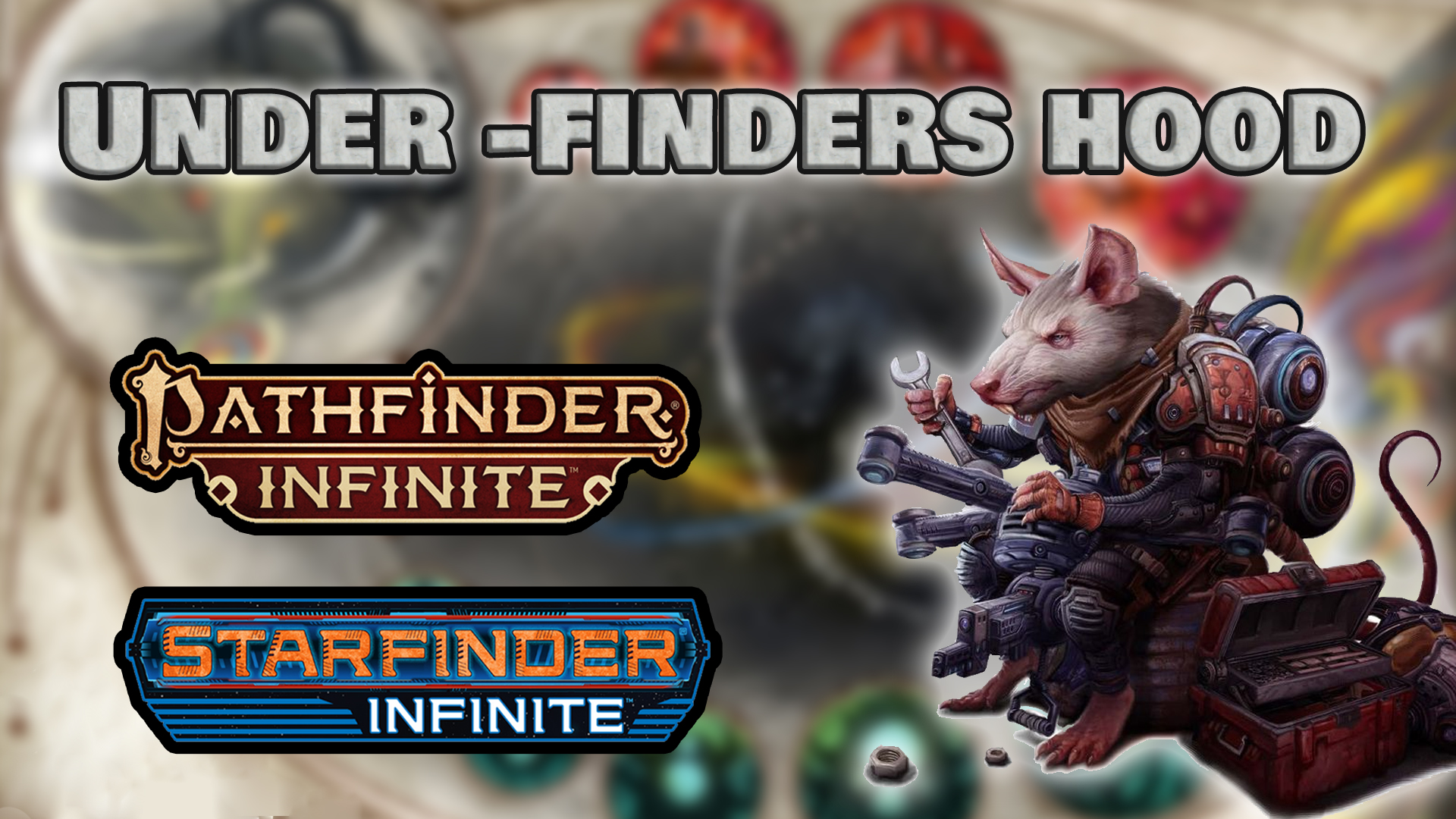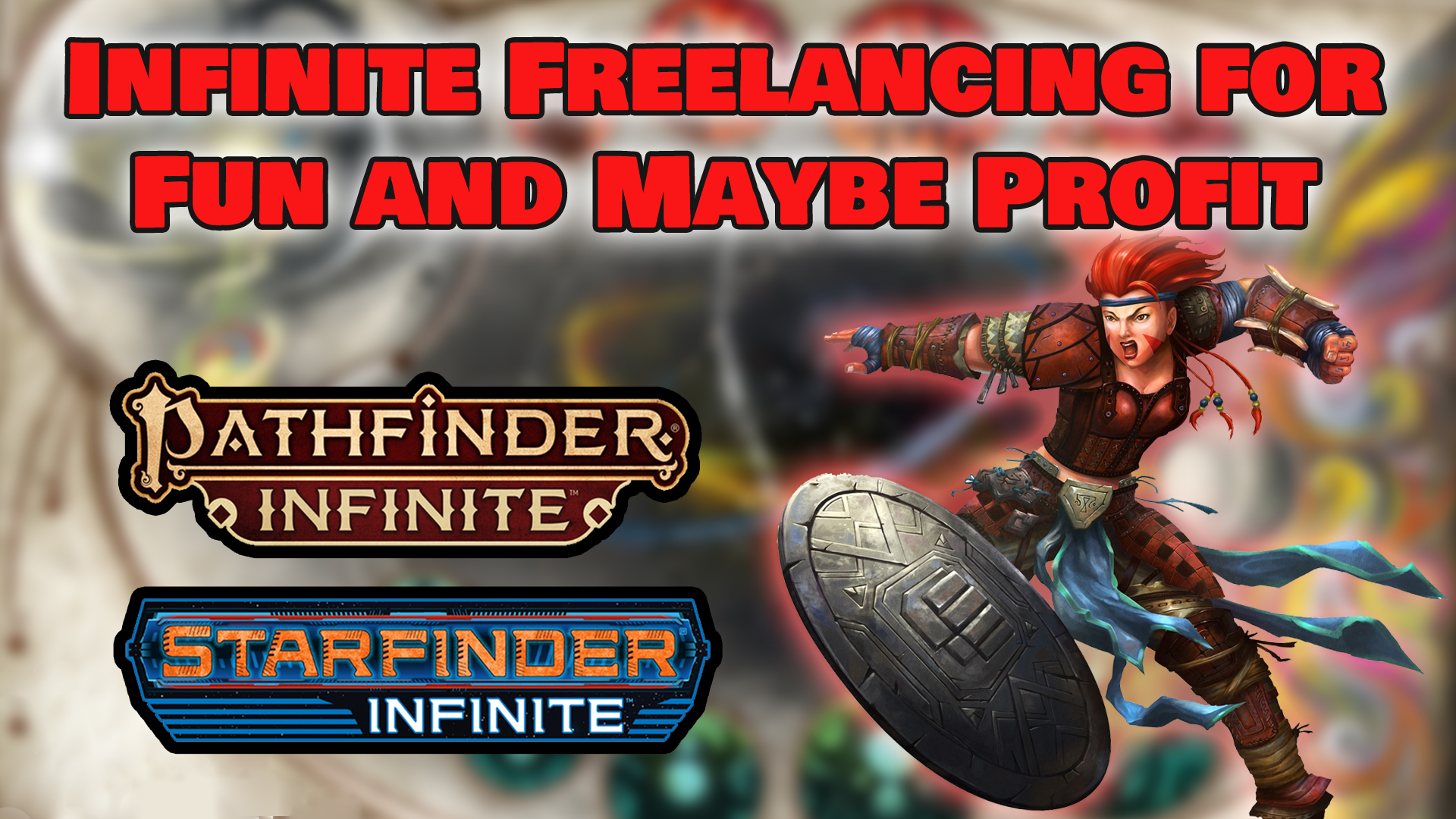So you want to write for Infinite, but you don’t know where to begin on balancing the mechanical aspects of your product? You’ve come to the right place. I’m Jessica Redekop and this is UnderFinder’s Hood.
I was hesitant to take on an article focused on mechanics, because it’s not exactly my specialty, either. I can share my strategy with you for how I write mechanics even when I’m not so great at them, though, and I’ve also brought in a crew of other Paizo freelancers to share their tips, too: Rigby Bendele, Kate Baker, Dennis Muldoon, Dave Nelson, Isis Wozniakowska each shared their tips, and Isabelle Thorne assisted us with consultation, feedback, and editing. Enjoy!
Trace, Copy, Remix
By Jessica Redekop
Whenever I create new content for Pathfinder or Starfinder, I always start by reading existing examples of whatever I’m going to create. When I’m getting ready to create a Pathfinder archetype, I look at existing archetypes; when creating ancestries, I look at existing ancestries. You’ll always find valuable information by looking for and dissecting the rules already at work in the system. For example, many ancestries have feats that grant weapon proficiencies. You can model a weapon proficiency feat for a new ancestry from the ample existing examples, and know your feat is balanced if it falls in line with the others. The same can be said for how many skill proficiencies an archetype dedication should give, how high a monster’s resistances should be, or how much damage an NPC should deal.
Always start by tracing an existing piece of work to practice and build your eye for good design. Pick an existing ancestry to reflavour; rename it, then make small changes to the feats it provides, switching out skill proficiencies and other features.
Next, you can move on from tracing to copying; instead of starting with an ancestry to use as a base and applying your changes to it, you can look through the existing ancestries in aggregate for inspiration, and take the parts you like. Model your ancestry feats off the ones already in the books, tweaking and combining existing feats to achieve the results you want.
Once you’ve built up your skill at tracing and copying, you’ll have created enough ancestry feats to know by feel when your new ideas are balanced against existing options.
You can apply this trace to copy to remix framework to all parts of the game, from ancestries to archetypes to items to even encounters and adventure writing. You can never go wrong by looking to existing material for inspiration and precedent.
Story-Focused Options (With a Point!)
By Rigby Bendele
Story is the heartbeat of any tabletop roleplaying game. Providing ways for players to act within those stories is at the core of my design philosophy. Narrative-driven design provides tools to make these story beats happen. Often, I start by identifying a specific experience that a player would want to act out with a character and to create ways to reward those experiences. However, it should still be an experience that comes up regularly enough that it’s worth the trade-off of another choice – often, story-focused character options fall flat due to limited usability. As a result you’ll want to support story beats that come up regularly, such as intimidating a humanoid enemy you have at sword point.
The abilities are often best done as linked class feats in Pathfinder 2E or as options within major class features in Starfinder (such as a mystic’s connection). PF2E’s 3-action system is a particular boon in writing abilities that create a story mid-combat. While these are commonly seen in creature stats, this is fertile ground for creating class feats that grant activities. With my earlier example, perhaps I would design a swashbuckler class feat that allows a PC within arm’s reach to attempt to Demoralize as part of a action that also allows a Strike, and then an additional feat that allows a PC to attempt the check with by flirting at swordpoint with Diplomacy.
Follow What Came Before
By Kate Baker
Communicating complex game rules through text is difficult. Noticing ambiguity in your own writing is almost impossible since, after all, you know what you meant, and it’s hard to think of every corner case that can arise. On top of all that, you still want your mechanics to read like part of a game, with elegance and flow. While it’s impossible to do all of that perfectly, it helps quite a bit not to reinvent the wheel. Look at what is already out there, and reference it whenever you can.
If you’ve written a custom ability for a monster, but what you’ve written is 95% like the fear spell, just reference fear instead. There’s less chance of getting interpreted wrong. If you create an archetype where the PC gets something much like an existing feat, reference the feat and explicitly call out the additions that your archetype adds. This makes it crystal clear if you’ve got the level wrong for your ability, as well. If you are giving a 12th level class feat to your archetype at 6th level, something is decidedly wrong.
This concept isn’t limited to referencing abilities in their entirety, either. Do you want a reaction that triggers when an opponent gets a crit against you? Go find another ability with the same condition and see how it is worded. Using consistent phrasing helps GMs and players understand how your content works. If you consistently find that existing content covers a smaller or larger scope than what you’re trying to write, that’s a good hint that your balance is off.
Altogether, paying attention to the content that came before yours aids in mechanical balance, clarity, and making life easier on yourself.
Make it Useful, Make it Fun!
By Dennis Muldoon
When creating player options in Pathfinder 2nd Edition, it’s important to keep two key questions in mind: (1) Is this useful? (2) Is this fun? While the answers are subjective, they can still serve as a guide during design and as a reality check when evaluating an option.
First, is this useful? Does this option add something meaningful to the character’s abilities? If the option provides a numerical bonus, does that bonus stack with common bonuses the character is likely to already have, given the limited set of bonus types in Pathfinder 2e? For example, if a feat provides a fighter a +1 status bonus to their attacks, that won’t stack with a bard’s inspire courage or a cleric’s bless. Similarly, if an option provides a +2 circumstance bonus to initiative rolls, that won’t stack with the Scout exploration activity or the Incredible Initiative feat. Also consider the action economy of the PC the option is designed for. A feat that allows a wizard to spend an action to boost their summoning spells isn’t very useful, since those spells take 3 actions to cast. Similarly, a feat that boosts the effective hardness of a shield as a reaction would prevent that PC from using their reaction to Shield Block, defeating the purpose.
Second, is this fun? Does it allow the character to do something fun or impressive they wouldn’t normally be able to do? Does it look cool? Does it allow the player to easily weave it into the narrative of their turn? Something that just provides a bonus without anything else is much less fun than something that allows the character to do something impressive or unusual.
Tips for Writing Pathfinder Second Edition Mechanics
By Dave Nelson
The two things to keep in mind when creating mechanics, for player or GM, in Pathfinder Second Edition is to keep things as simple as possible and be sure to keep the numbers conservative. A feat or other ability should only be a paragraph or so, two if it is a spell with multiple things going on. Bonuses and penalties to rolls should never be higher than + or – 3 and do not make new types of bonuses. Allowing for easier stacking of these will skew the game math very quickly. A bonus of +1 is meaningful, +2 is something players will always want to get, and a +3 is the apex of bonuses. This stays true from levels 1 to 20 since the math is so tight, even +1 bonuses don’t go out of style.
Another good thing to be aware of is the actions something takes, and what that says about how often that will allow the character or other actor to use it. Three-action abilities will only be used if it is worth to the spend a whole turn on it. One-action abilities can be used twice or more in a turn, so consider them accordingly. Most flashy and meaningful things worth doing will likely be two actions- enough time so that they can’t be done back to back, but less enough that the actor can still do one other smaller thing.
High Magic Setting with Low Magic
By Isis Wozniakowska
Starfinder is a science fantasy setting, but I once had a friend describe it to me as a “high magic setting with low magic”, and I think that significantly shapes my view of it. With that in mind, Starfinder monster and NPC design seems simple at its core; just follow the chart of numbers, double checking everything, and throw on some class grafts when you need them. However, there’s a lot of nuance to the system when it comes to adding spells and magical effects.
Spellcasters make fantastic NPCs and villains, and often interact well with the technomagical aspects of the setting, but there are some things I want to point out. With Starfinder being a lower-magic game, there are certain spells that are distinctly difficult to counter at the levels where they first become available. For example, greater invisibility is really only countered by see invisibility—which is a personal-only spell and something you cannot rely on a party to always have—or by a 10th-level armor upgrade which can be used a maximum of 5 minutes per day.
Likewise, when NPCs get their “at-will” spells per day, make sure to keep in mind what types of spells really would tear a party of PCs apart if a creature could easily use them every single round. While it might be thematic for your fire dragon to have at-will explosive blast, be mindful that if you expect the NPC to last several rounds, that is a lot of explosive blasts for players to have to dodge.
I greatly encourage anyone, whether producing content for home games or publication, to look into spellcasting grafts and try giving NPCs spells on top of special abilities. An extra bit of spellcasting works to remind us that Starfinder is the magical science fantasy setting that it deserves to be. But always be mindful that Starfinder is, mechanically, a lower magic setting, and what that means for parties that go through your adventures or encounter your creatures.
Thanks for joining us! This has been Jessica Redekop, Rigby Bendele, Kate Baker, Dennis Muldoon, Dave Nelson, and Isis Wozniakowska. Special thanks to Isabelle Thorne for assisting our article by providing thorough editing and feedback!






